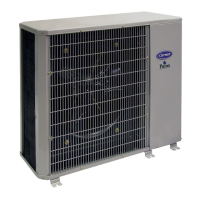19
TROUBLESHOOTING
This section provides the required flow charts to troubleshoot
problems that may arise.
NOTE: Information required in the diagnoses can be found
either on the wiring diagrams or in the appendix.
Required
Tools:
The following tools are needed when diagnosing the units:
S Digital multimeter
S Screw drivers (Phillips and straight head)
S Needle--nose pliers
Recommended
Steps
1. Refer to the diagnostic hierarchy charts below and
determine the problem at hand.
2. Go to the chart listed in the diagnostic hierarchy and follow
the steps in the chart for the selected problem.
For ease of se rvice, the indoor unit is equipped wit h diagnostic code
display LEDs in the indoor unit s. This diagnost i c display i s a
combination of flashing LEDs on the display panel or the front of the
unit. If pos si bl e, alw ays che ck the diagnostic codes displaye d on the
indoor uni t. Once a failure occur s wi th the indoor uni t i n operation,
the gre en LED on the indoor unit fl ashes at inte rvals of 0.5 sec onds .
The fault code is de duce d from the number of ti m es the gr ee n LED
flashe s, blocking unit oper ation. Betwee n one fl as h cycle and the next
one, a pause of 3 to 4 seconds elaps es.
The diagnostic codes for the indoor units are listed in the appendix.
Problems may occur that are not covered by a diagnostic code,
however are covered by the diagnostic flow charts. These problems
are typical air conditioning mechanical or electrical issues that can
be corrected using standard air conditioning repair techniques.
INDOOR UNIT DIAGNOSTIC
CODES
Table 17 – Fault Codes
No. Malfunction Running lamp Timer lamp Defrosting lamp Alarm lamp
Display
(digital tube)
1
Open or short circuit of
T1 temperatu re sensor
X
☆
X X E2
2
Open or short circuit of
T2 temperatu re sensor
☆
X X X E3
3 Indoor EEPROM
☆ ☆
X X E7
4 Water--level alarm X X X
☆
E8
5
Refrigerant leakage
detection
☆
X X
☆
EC
NOTE: O (on) X(off) ☆(flash at 5 Hz) ◎(flash at 0.5Hz)
For problems requiring measurements at the control boards please note the following:
For Heat Pump Units
Only:
1. Always disconnect the main power.
2. When possible check the outdoor board first.
3. Start by removing the outdoor unit top cover.
4. Reconnect the main power
5. Probe the outdoor board inputs and outputs with a digital
multi--meter referring to the wiring diagrams.
6. Connect the red probe to hot signal and the black probe to
the ground or negative.
7. Note that some of the DC voltage signals are pulse and
gives continuously variable readings.
ForCoolingonlyandHeatPumps
1. If it is necessary to check the indoor unit board you must
start by disconnecting the main power.
2. Next remove the front cover of the unit and then control
box cover.
3. Carefully remove the indoor board from the control box,
place it face up on a plastic surface (not metal).
4. Reconnect the main power and repeat steps 5, 6, and 7.
5. Disconnect main power before reinstalling board to avoid
shock hazard and board damage.

